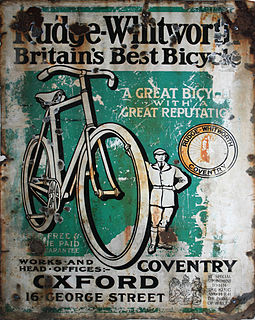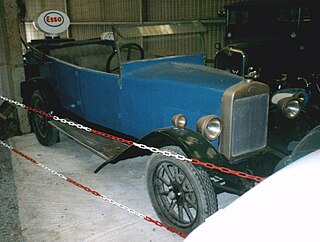
Coventry Premier Limited owned a British car and cyclecar manufacturing business based in Coventry from 1912 to 1923. It changed its name from Premier Cycles to Coventry Premier Ltd in November 1914.

Coventry Premier Limited owned a British car and cyclecar manufacturing business based in Coventry from 1912 to 1923. It changed its name from Premier Cycles to Coventry Premier Ltd in November 1914.
The business can trace its origins back to 1875 when William Hillman and William Herbert formed Hillman & Herbert Cycle Co Ltd, as bicycle makers. They were joined in 1876 by George B Cooper and the company renamed Hillman, Herbert & Cooper Ltd, operating out of the Premier Works in Coventry, their Premier brand of cycles being very successful, with the factory covering 3 acres.
In 1891 The Premier Cycle Co Ltd was formed to take over Hillman, Herbert & Cooper as a going concern, however the Premier Cycle Co was wound up later that year. Some time later The New Premier Cycle Co was formed to acquire the business of The Premier Cycle Co. In 1902 this company renamed itself as The Premier Cycle Co Ltd.
In 1914 The Premier Cycle Co Ltd changed its name to Coventry Premier Ltd, and continued as such until sold to Singer in 1920. The Coventry Premier trademark continued to be used by Singer until c1927 when they ceased bicycle production.
William Hillman went on to set up his own Hillman car company in 1907.
Hillman, Herbert & Cooper started manufacturing motorcycles from 1908.
The Premier cyclecar was launched in 1912. Described at the 1912 Motor Cycle and Cycle Car Show [1] as 'a smart looking two-seater vehicle with coachwork torpedo-type body at 100 guineas'. The engine was a 998 cc air-cooled V-twin (85mm bore, 88mm stroke) with special heavy flywheel for cyclecar work and Bosch magneto. The transmission included a leather cone clutch and two speed gearbox (with reverse), and the rear axle included a differential, there was enclosed chain drive throughout. The chassis was of 'tubular trussed construction' with half elliptic front springing and quarter elliptic rear. The brakes comprised a foot-operated band brake operating on the transmission countershaft, and two internally expanding brakes on the rear axle operated by the hand brake lever.
A proper light car designed by the works manager G.W.A. Brown, who had been with Talbot, was added in 1914 with four-cylinder engine of 1592 cc and shaft drive. Testing of the 4-cylinder car continued during the war, but when peacetime production restarted in 1919 it did not appear. Brown had moved to Arrol-Johnston in 1917. Instead the company launched the 8 hp Super Runabout two-seat, three-wheeled cyclecar with 1056 cc, water-cooled, V twin engine, shaft drive to a rear-mounted gearbox and chain drive to the rear wheels.
In 1921 Coventry Premier was bought by Singer [2] and the three-wheeler was replaced by a four-wheeled version using the same engine but now having the gearbox combined with the rear axle, eliminating the chain drive. In 1923 the badge appeared on a basic version of the Singer Ten. The name was no longer used on cars from 1924, but bicycle making continued for a few more years.
AJ "Jimmy" Dixon of Clacton raced a Coventry Premier (No 8) in the 1921 Brooklands Junior Car Club 200 mile race. He finished in fourth place.
About 500 three-wheel and 1200 four-wheeled cars were made. [2]
The Adamson was an English car manufactured in Enfield, Middlesex, from 1912 to 1925. It was designed by Reginald Barton Adamson at the premises of the family haulage contract business.
Coventry Victor was a British motorcycle and car manufacturer. Originally Morton & Weaver, a proprietary engine manufacturer in Hillfields, Coventry, founded in 1904, the company changed its name to Coventry Victor Motors in 1911, the company closed in 1971.

Tiny was a British cyclecar manufactured by Nanson, Barker & Co at Esholt, Yorkshire between 1912 and 1915.
Singer Motors Limited was a British motor vehicle manufacturing business, originally a bicycle manufacturer founded as Singer & Co by George Singer, in 1874 in Coventry, England. Singer & Co's bicycle manufacture continued. From 1901 George Singer's Singer Motor Co made cars and commercial vehicles.

The Swift Motor Company made Swift Cars in Coventry, England from 1900 until 1931. It grew progressively from James Starley's Coventry Sewing Machine Company, via bicycle and motorised cycle manufacture. The cars ranged from a single-cylinder car in 1900 using an MMC engine, through a Swift-engined twin-cylinder 7-horsepower light car in 1904, and a 3-litre model in 1913. After the First World War a successful range was sold during the 1920s, but the Cadet of 1930 was its last vehicle as it could not compete economically with volume manufacturers such as Ford and Morris Motors.

The Riley Nine was one of the most successful light sporting cars produced by the British motor industry in the inter war period. It was made by the Riley company of Coventry, England with a wide range of body styles between 1926 and 1938.

Rudge Whitworth Cycles was a British bicycle, bicycle saddle, motorcycle and sports car wheel manufacturer that resulted from the merger of two bicycle manufacturers in 1894, Whitworth Cycle Co. of Birmingham, founded by Charles Henry Pugh and his two sons Charles Vernon and John, and Rudge Cycle Co. of Coventry.

Douglas was a British motorcycle manufacturer from 1907–1957 based in Kingswood, Bristol, owned by the Douglas family, and especially known for its horizontally opposed twin cylinder engined bikes and as manufacturers of speedway machines. The company also built a range of cars between 1913 and 1922.
The Elfe was a French automobile, manufactured in Lavallois, Paris, from 1919 until about 1925 by Ateliers Defrance Freres. The company was founded by M. Eugene Mauve, who was also the instigator of the Bol d'Or race for cyclecars and latterly motorcycles, now held at the Le Mans circuit in France. During its brief life, the company entered numerous races, under various names including ELFE, Elfe-Anzani, Elfe-DeFrance and Mauve.
The Rover 8 was a small single-cylinder eight-horsepower 1327 cc car made by the British Rover car company. It was Rover's first production car. It was remarkable for being supported by a backbone chassis rather than a conventional ladder frame. The first model was manufactured from 1904 to 1912, A Daimler-Knight sleeve-valve engine option was available in 1911 and 1912.

The Carden was a British 4 wheeled cyclecar made from 1914 by Carden Engineering originally based in Farnham, Surrey but moving in 1914 to Teddington, Middlesex and in 1919 to Ascot, Berkshire.
The Perry was a British car made by the Perry Motor Company based in Tyseley, Birmingham who made cars between 1913 and 1916.

Premier Motorcycles were British motorcycles manufactured by a business founded as a bicycle manufacturer by W. H. Herbert and William Hillman in 1876. Their "Hillman and Herbert Cycle Company" was renamed "Premier Cycle Co." in 1891.

The Austin 40 hp is a 4-cylinder motor car launched at the Olympia Motor Show in November 1907. Manufactured by Austin at Longbridge, Northfield, Birmingham, it was the first variant from Austin's initial plans for a two model range of a 15 hp —which they had dropped—and a 25 hp car.

The Little Midland or LM was a British 4-wheeled cyclecar made from 1910 to 1922 by the Little Midland Light Car Co Ltd in various places in Lancashire.

The Warren-Lambert Engineering Co. Ltd. was a British automobile manufacturer that was established from 1912 to 1922 in Richmond, then in Surrey. A. Warren Lambert, was an agent for Morgan cars in Putney which he also raced. In 1912 he designed and started to manufacture a two-seat four-wheel cyclecar from premises in Uxbridge Road, Shepherd's Bush. It was well received and around 25 cars a week were being made.
The Singer Ten name was used for several automobiles produced by Singer Motors between 1912 and 1949. The "Ten" in the name referred to the taxation horsepower rating in the United Kingdom.
The Day-Leeds was a British automobile manufactured by Job Day & Sons of Leeds, Yorkshire.

The Autocrat was a British car manufacturer operating from 1913 to 1926. The company operated from premises in the Balsall Heath area of Birmingham. Unusually for the time the company seems to have been run by two women, Ivy Rogers and Miss Howell.

The Rhode was a British car made from 1921 to 1930. Mead and Deakin Ltd had started in business making cycle and motor cycle components. They also made the "Canoelet" sidecar. In 1912 they made at least two cyclecars under the name of Medea with 1244cc Chapuis-Dornier engines but these did not go into series production.